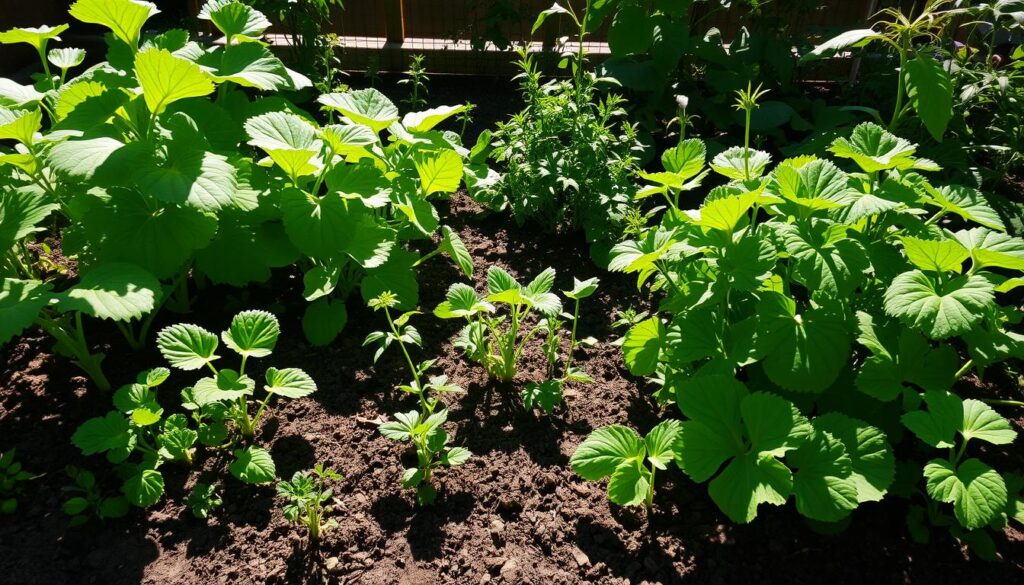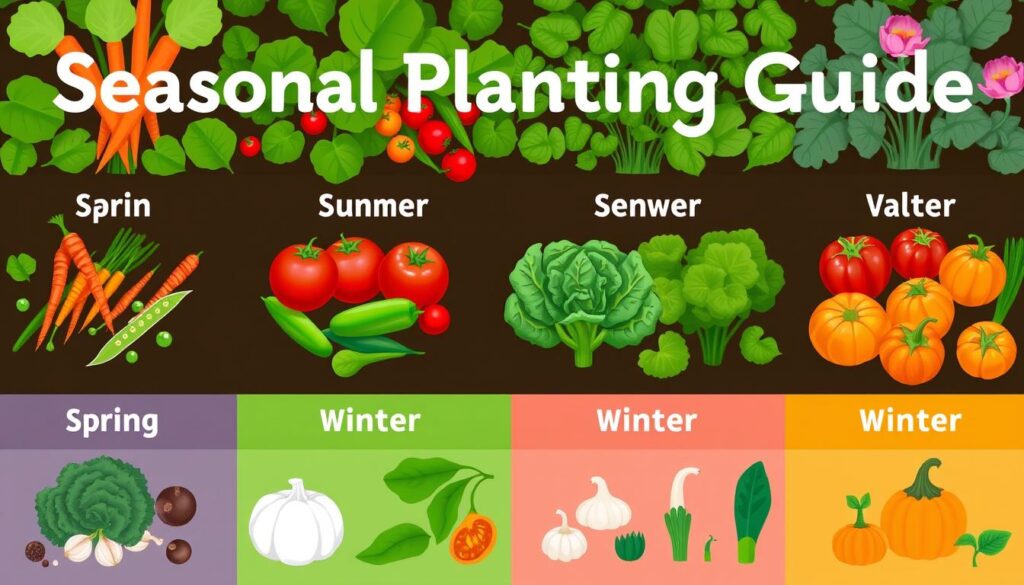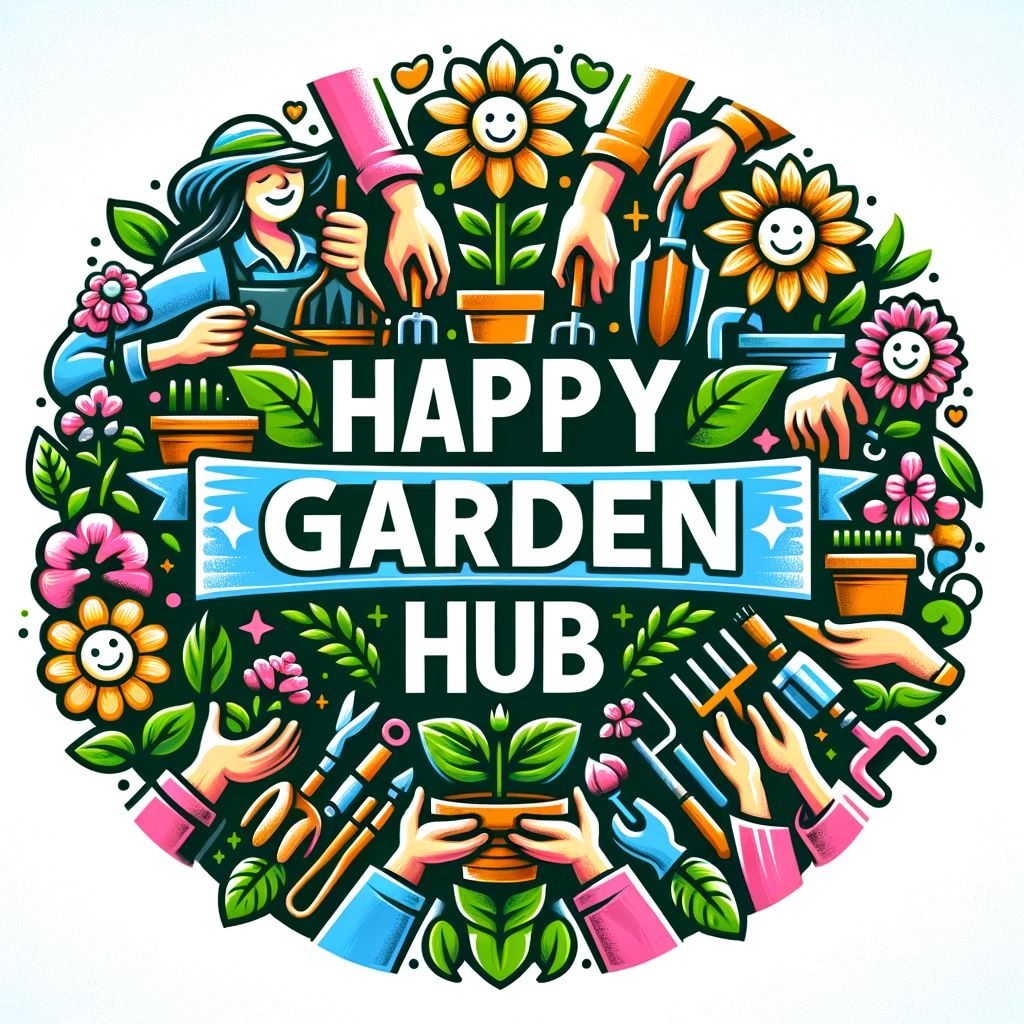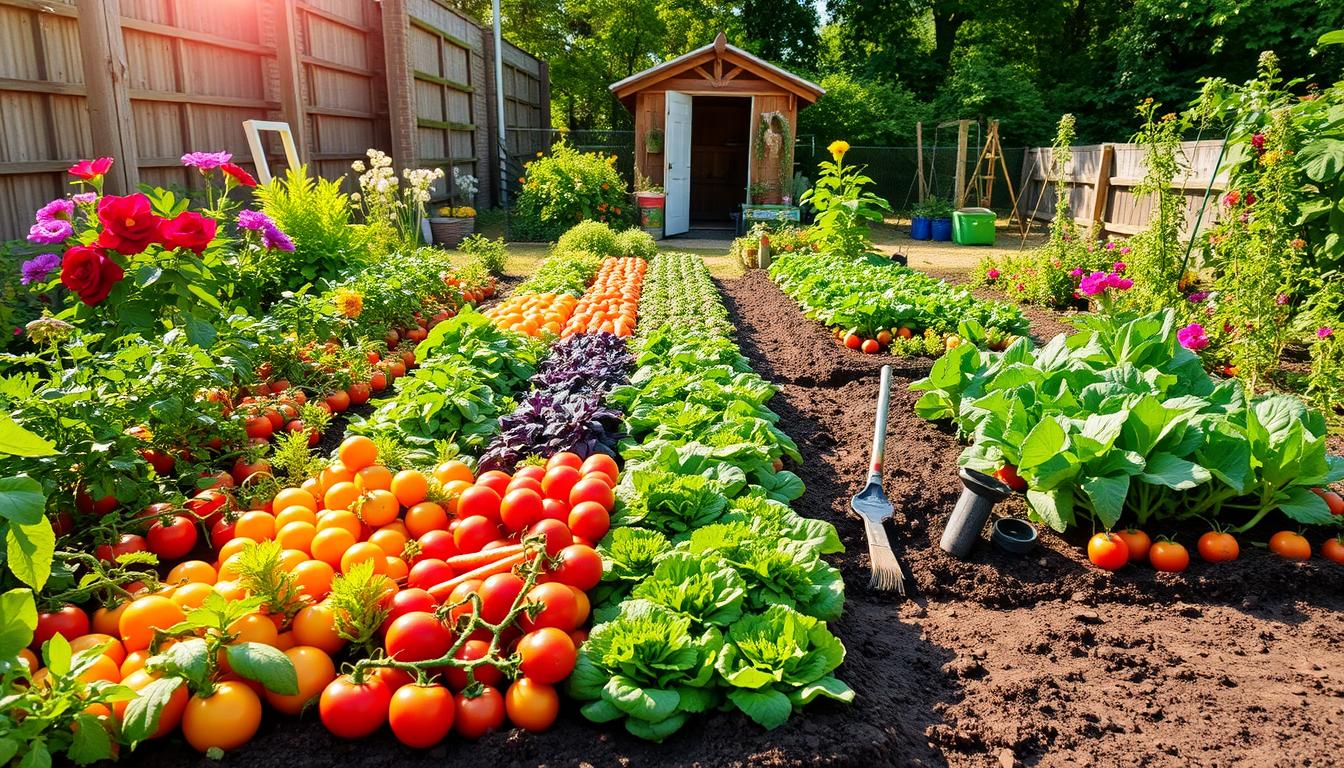This post contains affiliate links.
Imagine walking into your backyard and smelling fresh vegetables. The colors of ripe tomatoes, peppers, and herbs show your hard work. Vegetable garden planning is more than planting seeds. It’s about connecting with nature and feeding your family.
With the right garden design, your hard work will pay off. You’ll enjoy a bountiful harvest. Every effort will be worth it.
Starting your green journey requires planning. It’s important to think before planting. Whether you want big raised beds or small containers, planning is key. It helps avoid problems later.
Think about sunlight and water when planning. These are crucial for a successful garden. Let’s explore what makes a garden thrive, with tips for a beautiful garden.
Key Takeaways
- Planning a garden layout is essential for a successful harvest.
- Sunlight is critical—most vegetables need 6 to 8 hours of exposure daily.
- Consider using raised beds to improve drainage and soil quality.
- Start small with containers or a few raised beds if you’re a novice.
- Strategic plant placement can maximize growth and accessibility.
- Utilize companion planting for better yields and pest control.
- Growing seedlings can save money compared to purchasing mature plants.
Understanding the Basics of Vegetable Garden Planning
Vegetable garden planning is key to a successful garden. The first step is to design your garden layout. Knowing the garden size is important. A 10’ x 10’ ground garden or a 4’ x 4’ raised bed is good for beginners.
A bigger garden, like 12’ x 24’, can feed a family of four. It’s all about finding the right size for your needs.
Knowing what plants need is crucial. Most veggies need 6 to 8 hours of direct sunlight each day. Without enough light, they won’t grow well. Start with 3 to 5 plants of each type for beginners.
Some easy plants to grow are lettuce, tomatoes, and zucchini. They’re great for beginners.
Seasons change what you can plant. Cool-season crops like peas and spinach do well in early spring. Warm-season crops, like beans and tomatoes, prefer warmer weather.
Using tools like the Garden Planner by the Old Farmer’s Almanac can help. It makes planning easier by figuring out plant spacing and when to plant and harvest.
Choosing the Perfect Location for Your Garden
Finding the right spot for your vegetable garden is key to success. Several factors are important when picking the perfect location. These include sunlight, water, and avoiding competitive plants.
Assessing Sunlight Requirements
Most vegetables need at least six hours of direct sunlight a day. Even better, they thrive with eight hours. To find the best spot, measure sunlight hourly in different areas. This ensures your plants get enough sunlight to grow well.
Understanding Proximity to Water Sources
Having water close by makes gardening easier. Place your garden near a water source for easy watering, especially when it’s dry. A rain barrel can also help collect water, making watering sustainable. Try to keep your garden close to plumbing or natural water sources.
Avoiding Competitive Vegetation
Stay away from trees and big shrubs when choosing a location. They can steal nutrients and water from your vegetables. Pick a spot where no big plants will compete with your crops. Make sure to plan your garden layout carefully to avoid this issue.

| Vegetable Type | Sunlight Requirements | Water Needs (per week) |
|---|---|---|
| Leafy Greens | 4-6 hours | 1 inch |
| Root Vegetables | 6-8 hours | 1 inch |
| Fruiting Vegetables (e.g., Tomatoes) | 6-8 hours | 1 inch |
Follow these tips to grow a healthy garden. Make sure it gets enough sunlight, has easy access to water, and avoids competition from other plants. For more gardening advice, check out Happy Garden Hub.
Defining Your Gardening Goals
Setting clear gardening goals is key to a successful gardening journey. You might want to grow fresh produce, enjoy native plants, or become self-sufficient. Knowing your goals helps you choose the right plants for your needs.
Determining Space Limitations
First, figure out how much space you have. Your space can help decide how big your garden will be. Start small if you’re new, like using containers or vertical gardens.
This approach lets you grow without feeling overwhelmed. In cities, using every inch can help you grow more while staying within your goals.
Setting Expectations for Self-Sufficiency
It’s important to set realistic goals for self-sufficiency. Think about your grocery bills and what you like to eat. Look at your time, budget, and space for planting.
This helps you make a plan that fits your needs. Use tools like online planners or spreadsheets to stay on track. This keeps you motivated and lets you see your progress.
For more tips and inspiration, check out this informative guide. Enjoy the journey and celebrate every step, no matter how small. Keeping a garden diary can help you reflect on your growth.
Mapping Out Your Garden Layout
Creating a good garden layout is key for a productive vegetable garden. It helps use space well, makes it easier to get around, and keeps plants healthy. Using graph paper is a great way to plan where each plant goes, ensuring they grow well.
Using Graph Paper for Accuracy
Graph paper is a great tool for drawing your garden’s size and where plants will go. Start with a size like 10′ x 10′. This lets you measure accurately, making it easier to plan paths between beds.
Make sure paths are at least 2 feet wide. This way, you can easily care for your garden without stepping on plants.
Visualizing Plant Spacing Techniques
It’s important to space plants right to prevent overcrowding. Group plants by size and how much shade they need. Place taller plants like tomatoes and pole beans where they won’t block sunlight from shorter plants.
Using square foot gardening can make your garden more efficient. It lets you grow many different plants in a small space. Keep track of how sunlight changes with the seasons to move plants for better sunlight.
Here’s a table to help you plan your garden layout:
| Plant Family | Example Plants | Optimal Spacing (inches) | Sunlight Requirement (hours/day) |
|---|---|---|---|
| Allium | Onions, Garlic | 4-6 | 6-8 |
| Solanaceae | Tomatoes, Peppers | 18-24 | 6-8 |
| Brassica | Broccoli, Kale | 12-18 | 6-8 |
| Cucurbit | Cucumbers, Squash | 36-48 | 6-8 |
| Legume | Beans, Peas | 2-4 | 6-8 |
Vegetable Garden Planning: Selecting Your Crops
Choosing the right vegetables is crucial for a successful garden. It’s important to pick ones you like, that grow well in your area, and fit your garden’s goals. Making a list of your favorite vegetables helps. It makes picking easier and helps with planning for crop rotation and getting the best yield.
Creating a List of Favorite Vegetables
Start by writing down vegetables you and your family love. Think about what they need to grow, when they’re in season, and if they resist pests and diseases. A mix of leafy greens, root veggies, and fruit-bearing plants will make your garden more productive. Some popular picks include:
- Tomatoes
- Spinach
- Cucumbers
- Carrots
- Peppers
- Broccoli
Understanding Seasonal Planting Guides
Knowing when to plant is key. Different veggies need specific temperatures and light. Cool-season veggies like lettuce and spinach do best in cooler temps. Plant them before the last frost.
Warm-season crops like tomatoes and peppers need it warmer. Plant them after the last frost. This avoids seedlings getting too big too fast.
Also, knowing your local hardiness zone helps. It tells you which veggies will grow best at different times. Using a seasonal guide ensures a steady harvest. This makes your garden more enjoyable.

Soil Preparation Methods for Optimal Growth
Getting your soil right is key to a great garden. Healthy soil means strong plants that fight off pests. Knowing how to prepare your soil is crucial for growing veggies well.
Improving Soil Quality with Organic Matter
To make your soil better, add organic stuff like compost or aged manure. These help your soil hold water and nutrients. They also make the soil good for plants to grow in.
Soil that’s a mix of sand, silt, and clay is best. Adding compost makes it even better for roots to grow.
Testing Drainage and Nutrient Levels
Testing your soil regularly is important. It shows if your soil has the right nutrients for plants. You can also check how well water drains by digging holes.
This helps spot problems early. Knowing your soil type helps pick the right fixes. This keeps your garden healthy and free from diseases.
| Soil Type | Characteristics | Best Uses |
|---|---|---|
| Clay Soil | Retains moisture; poor drainage | Suitable for plants that thrive in damp conditions |
| Sandy Soil | Drains quickly; allows oxygen flow | Ideal for root vegetables and drought-resistant plants |
| Silt Soil | Retains moisture; nutrient-rich | Versatile for most vegetable crops |
For more organic gardening tips, check out this link. It helps make your garden full of life and color.
The Benefits of Raised Bed Gardening
Raised bed gardening is a smart way to improve your garden. It creates a special area for plants, making your garden look better. It also helps with soil drainage and lets you grow plants in the best conditions. This method helps you use your space better and grow more food.
Maximizing Space and Production
Raised bed gardening is great for growing more in less space. A study at Dawes Arboretum in Ohio showed that raised beds can almost double your harvest. You can plant closer together, which means more food from a small area. Plus, the soil warms up faster in spring, so you can start planting sooner.
Improving Soil Drainage and Mixing Options
Good soil drainage is key for healthy plants, and raised beds do a great job. The soil is loose, which stops it from getting compacted. This lets roots grow well. You can also mix the soil to match what your plants need, making it better for them. Raised beds also help keep weeds down by planting closely together.
Raised beds can be made in different heights, which is good for everyone. They make gardening easier and more comfortable, especially for those who have trouble moving around. You can make them as high as your waist, making gardening a breeze.
Raised beds also make your garden look nice. They help you keep your garden tidy and make it look better. For more tips on gardening, check out this guide on garden maintenance tips.
| Feature | Raised Bed Gardening | Traditional Gardening |
|---|---|---|
| Soil Drainage | Improved, less compaction | May suffer from compaction |
| Space Efficiency | Higher yield per square foot | Lower yield |
| Customization | Height and soil mixture tailored | Standard ground level |
| Weed Control | Dense planting reduces weeds | Requires regular maintenance |
| Accessibility | Can be raised for ease of access | Generally requires bending or kneeling |
Effective Plant Spacing Techniques for Garden Success
Successful vegetable gardening needs careful plant spacing techniques. Each plant must get enough light, nutrients, and water to grow well. When planning your garden, think about how big each plant will get.
This prevents overcrowding. Overcrowding can cause poor air flow and competition for resources. For example, big plants like tomatoes and squash need more space than small ones like radishes or lettuce.
Considering Mature Plant Size
The size of plants when they’re fully grown is very important. Vegetables like tomatoes need lots of sunlight and space. Knowing how big they’ll get helps keep your garden productive.
Intercropping, where fast-growing plants are planted with slower ones, can save space. It works well if you plan with sizes in mind.
Utilizing Vertical Gardening Methods
Using vertical gardening, like trellises for climbing plants, saves space and improves air flow. This method boosts yields in small areas. It works well with plant spacing techniques to increase production without harming plants.
With these strategies, you can have a lively and efficient garden, even in small spaces.
FAQ
What is vegetable garden planning, and why is it important?
How can I determine the best location for my vegetable garden?
What factors should I consider when setting gardening goals?
How should I layout my vegetable garden?
How do I choose the right crops for my garden?
What methods can improve soil preparation?
What are the advantages of raised bed gardening?
How can I effectively space my plants in the garden?
This post contains affiliate links.

